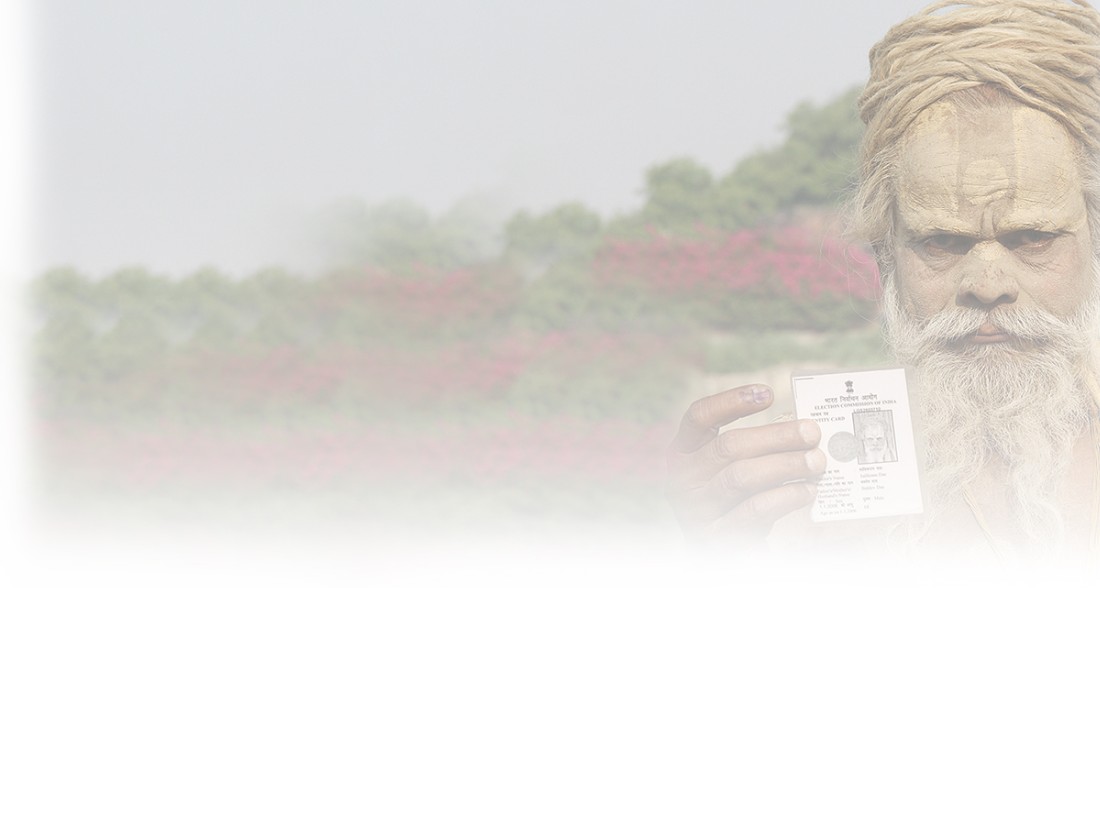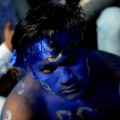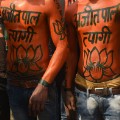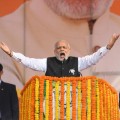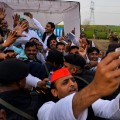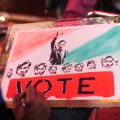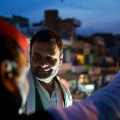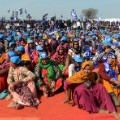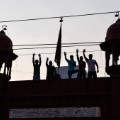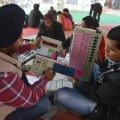Democracy and drama: 100 million Indians to cast pivotal vote
Updated 0723 GMT (1523 HKT) February 10, 2017
(CNN)Saturday sees the first vote cast in one of the world's biggest exercises in democracy.
From slums, villages, towns and cities, millions of people will make their way to polling stations, in a seven-phase election that takes place over four weeks in Uttar Pradesh, India.
If the 2012 election is anything to go by, they'll stand in line for hours, determined to leave their mark on the make-up of the 403 seats up for grabs on the state legislature.
Indian media has covered every twist and turn of the campaign. There have been family feuds, corruption accusations, rows over cow vigilante violence and recriminations over statues and misspent funds.
It's been nothing but dramatic, with most commentators saying the race is still wide open.
So why does it matter so much, and who are the major players involved?
WHERE IS UTTAR PRADESH?
The enormous state of Uttar Pradesh lies in India's north. It has a population of 200 million people; if it were a country, it would be the fifth largest on the planet -- bigger than Brazil.
It's home to the majestic Taj Mahal and India's holiest city, Varanasi. Some 200 million tourists flocked to Uttar Pradesh in 2015 to soak up one of India's most varied, colorful and vibrant regions.
It's also one of India's most poverty-stricken states and home to 8% of the world's poor. The population is blighted by illiteracy; according to the last census, only half the state's women are literate, well below the national average.
Over three quarters of the population are rural. Uttar Pradesh has the highest percentage of Dalits of any state -- traditionally seen as the lowest in India's caste system. Perceived as being "unclean," Dalits are considered untouchable by the higher castes.
In Uttar Pradesh the Dalit vote is critical and politicians will be looking to woo this group in an effort to make their mark on the ballot box.
In India, there's a famous saying: 'Indians don't cast their votes, they vote their caste.'
WHY ARE THE ELECTIONS THERE SO IMPORTANT?
As India's most populous state, it has the largest parliamentary representation and holds huge political sway.
Despite Prime Minister Narendra Modi's landslide victory in 2014, his Bharatiya Janata Party (BJP) has been forced into battle with an upper house where his party does not have the majority.
Key pieces of legislation have become stuck, and Modi's ability to enact his election promises of sweeping reform has been called into question.
These perceived failures to deliver have impacted his popularity. In 2015, he suffered decisive losses in the states of Bihar and Delhi, which further damaged his prestige and served to make parliament even more of an obstacle.
As well as boosting morale, a win in Uttar Pradesh would dramatically amplify the BJP's presence -- and strength -- in the upper house, and pave the way for a potential second term for Modi.
"The election is of enormous significance," says Sumit Ganguly, professor of Political Science at Indiana University. "In many ways, it could be harbinger of what's to come."
WHO ARE THE MAJOR PLAYERS?
Mayawati -- who goes by one name -- is a Dalit politician and an icon for millions of low-caste Indians.
She's previously had four terms as Chief Minister -- but in 2012 her Bahujan Samaj Party (BSP) was beaten convincingly by the Samajwadi Party.
For many, Mayawati embodies the Indian dream: a low-caste woman who overcame enormous odds to get to the top of the political pile.
Following a poor performance in the 2014 general elections, the BSP hasn't been viewed as one of the key players in this pivotal election -- until recently.
The tide turned when a video surfaced in July last year showing two Dalit men being brutally beaten up by so-called cow vigilantes.
Cows are revered in India and their slaughter is banned in several states, including in Uttar Pradesh. The vigilantes accused the Dalit men of killing the sacred animal rather than just skinning the carcass, as is their tradition.
The attacks received significant media attention and highlighted prevailing discriminatory, and occasionally violent, behaviors and attitudes towards people of the lowest caste. Nationwide protests ensued -- something that could work for Mayawati, who has long been seen as a defender of the Dalit population.
However, the colorful politician has been criticized in the past for displays of extravagance in the poverty-stricken state.
She's erected several statues of herself in public parks with funds critics suggested could have been better spent on social services.
"You can win with identity politics first time around, by saying, 'I'm one of you, I represent your interests, and I will fight for you and my victory will be your victory,'" says Sumit Ganguly, professor of Political Science at Indiana University. "But then, people want to see issues of bread and butter addressed -- not statues and edifices ... Mayawati, for all her talk, has done very little to improve their material conditions."
However, he says, her Samajwadi Party will probably still do well among the Dalit population. "The tragedy with Dalits is that they have finite choice. Talking to the BJP is hardly a viable option," he says. "Their alternatives are rather bleak."
In 2012, at the age of 38, Akhilesh Yadav became the youngest ever Chief Minister of Uttar Pradesh.
The youthful, tech-friendly politician's promises of free laptops and tablets for students seemed to appeal to the state's younger population.
He tapped into a demographic keen to shed traditional stereotypes associated with the impoverished state: "The new generation is aspirational," Yadav said in an interview with CNN affiliate, News18, in November. "They dream of great things and see a bright future for themselves."
In January of this year he cemented an alliance with Rahul Gandhi's India National Congress party -- together they'll be hoping to galvanize the youth vote.
However, the party has been blighted by dramatic family feuds. On December 30, Yadav was expelled from the party by his father, only to be reintroduced back into the fold less than 24-hours later, News18 reported.
"The party is a bit fractured," says Ganguly. "Some of the old guard have stuck with his father, some have defected."
Party infighting aside, what could stall Yadav in this election is a lack of evidence for tangible improvements in people's livelihoods over the last five years, Ganguly added.
Modi's BJP has opted not to name a candidate for chief minister, which means there isn't an individual linked to its campaign.
Ganguly says the BJP will be hoping to leverage "anti-incumbency sentiment" swirling around Yadav and his fractured Samajwadi party, rather than focusing on a "particular individual who could bring the electorate behind her or him."
He says Modi's supporters in Uttar Pradesh are likely to stick by the BJP -- viewing upper house deadlocks more as a form of obstructionism by opposition Congress, rather than a failure on the part of Modi.
Making Modi the face of the campaign could also work in the BJP's favor.
Despite setbacks, he remains a hugely popular leader; a Pew Research Center survey from September 2016 found that more than 81% of Indians "held a favorable view of Modi."
Muslim voters are a vital group for this election, and the BJP has a checkered history with them.
Modi was accused of allowing anti-Muslim riots in 2002. However, he's always denied any wrongdoing, making significant efforts to disprove assertions he would marginalize the Muslim community throughout his term.
Modi's move late last year to scrap its two largest rupee notes also hit the lower castes. Billed by the Prime Minister as a way to curb the influence of untaxed money -- or black money as it's known, Ganguly says the policy was rolled out ineffectively.
"Its effects were disproportionately on the backs of the poor," he says. "Many artisans and day laborers and people in menial occupations were not being promptly paid, and a bit of a backlash developed."
He says that while literacy is low in India, political awareness is not -- something that could hold the BJP back in this state.
"They simply can't do with the upper caste vote, that's not enough of a base."
In late January, the Indian National Congress party revealed it was forging an alliance with the state's ruling Samajwadi Party; vice president Gandhi and sitting Chief Minister Yadav were going to the polls together.
Congress has suffered recently in Uttar Pradesh and will see the alliance as a means of regaining lost ground in the region, as well as holding back Modi's BJP -- a tactic they've employed in other state races and will look to use again elsewhere if it proves successful.
But according to Ganguly, the last era of Congress national government is still fresh in voter's minds -- something the BJP is relying on.
"It was wracked with stratospheric financial scandal, which has really damaged its image," he says. The "quality of governance was so poor," and there were so many accusations of ministers who allegedly had their "hands in the till," says Ganguly, that Modi could capitalize on it -- something the BJP is gambling on in Uttar Pradesh.
Amidst the intrigue, however, there's one thing interested parties can be sure of over the next four weeks. Between now and March 11, when the final count takes place, it'll be a long and bitter fight for a state with some serious political punch.

